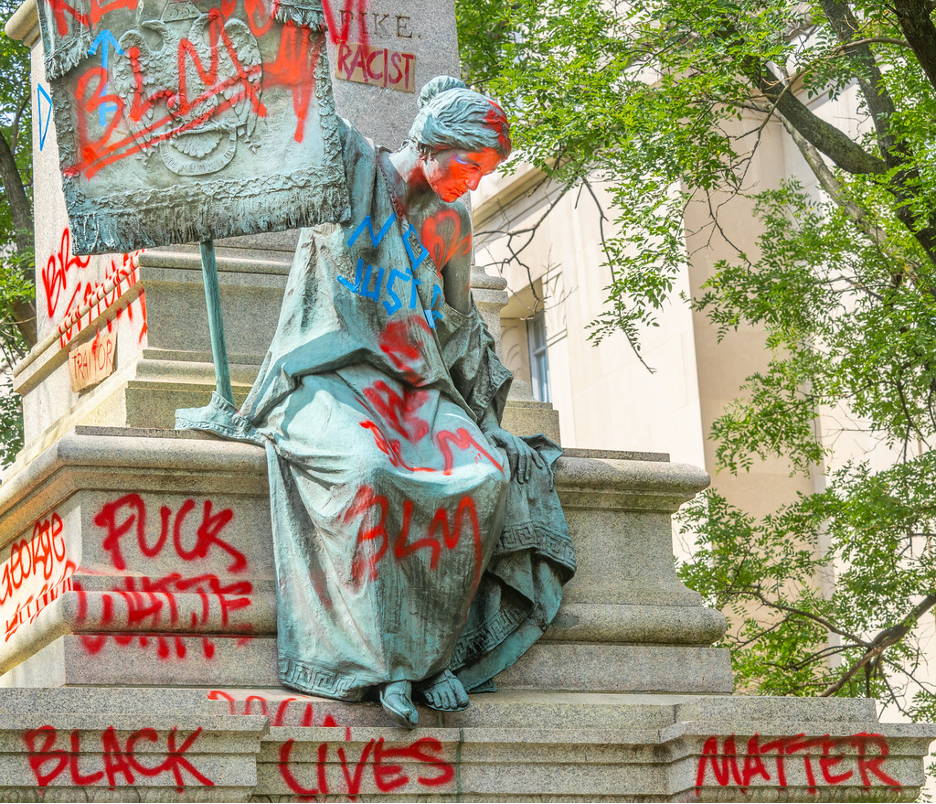By Gilbert C. Correa, Monuments Toolkit
2020 brought issues related to social justice into focus. As the COVID-19 pandemic raged on, the world heritage community had to contend with the destruction of problematic monuments during the civil unrest that occurred after the tragic murder of George Floyd in the spring of 2020. Statues, sculptures, obelisks, and other immovable monuments were toppled, vandalized, marred, and removed from both public and private spaces throughout the United States and the globe. This blogpost shares the tremendous impact social justice protests (spring 2020 to spring 2022) have had on monuments in the United States.
Figure 1
Social Justice Protest Density Impacting Monuments (Spring 2020-Spring 2022)
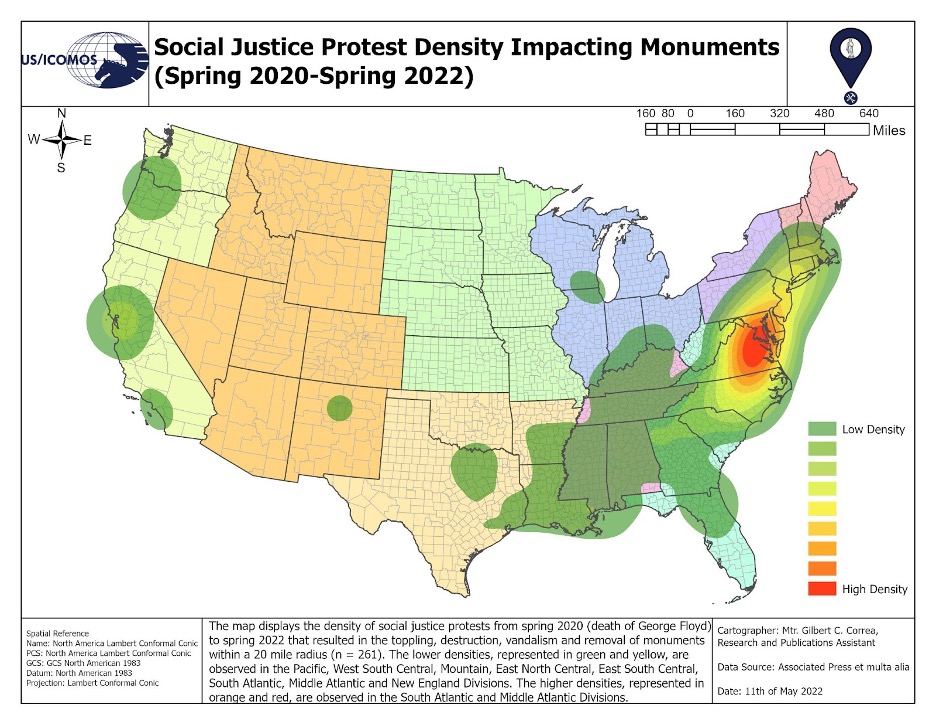 Note. The density of social justice protests (from spring 2020 to spring 2022) that directly impacted monuments within a 20 mile radius (n = 261). (Map by Gilbert C. Correa).
Note. The density of social justice protests (from spring 2020 to spring 2022) that directly impacted monuments within a 20 mile radius (n = 261). (Map by Gilbert C. Correa).
As shown in Figure 1, the colors orange and red represent the geographic locations with the highest densities of social justice protests where monuments were targeted. There were a total of 261 incidents where protests led to the toppling, destruction, vandalization and removal of monuments. The higher densities are observed in the northeastern South Atlantic (i.e. North Carolina, Virginia, North Carolina, Maryland, Washington, D.C. and Delaware) and southeastern Middle Atlantic (i.e. New Jersey and Pennsylvania) divisions. There is a direct correlation between the high number of social protests in these geographic areas and the high number of controversial monuments (i.e. confederate and colonial).
Figure 2
Types of Targeted Monuments (n = 261)
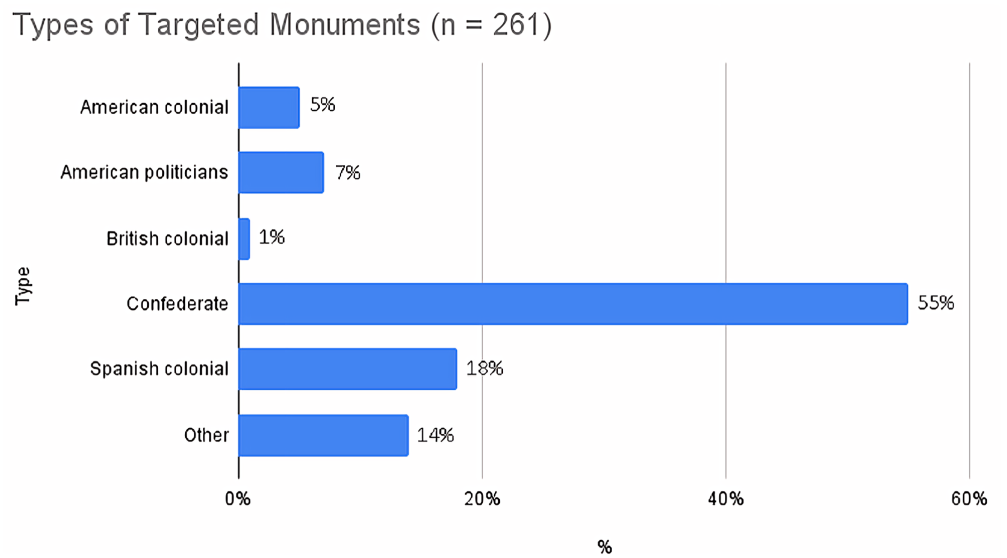
Note. The overall classification of targeted monuments in the United States during the social justice protests from spring 2020 to spring 2022. (Graph by Gilbert C. Correa)
Figure 2 illustrates that out of 261 total incidents, confederate monuments (144 or 55%) were the largest group destroyed. Although protestors originally targeted confederate statues throughout the South Atlantic Division (such as Robert E. Lee and Stonewall Jackson on Monuments Avenue in Richmond, Virginia), eventually they began targeting monuments of other groups. Exemplī grātiā, Native Americans such as Christopher Columbus in Baltimore, Maryland; Don Juan de Oñate in Albuquerque, New Mexico; and Junipero Serra in Sacramento, California.
Additionally, the monuments of American presidents such as Thomas Jefferson in New York City, New York; George Washington in Portland, Oregon; Ulysses S. Grant in San Francisco, California; and Andrew Jackson in Washington, D.C., were amongst the many toppled, vandalized, and removed. It is interesting to note that even monuments of figures who were against racism and slavery were also targeted, such as the statues of abolitionists Frederick Douglass in Rochester, New York; and Hans Christian Heg in Madison, Wisconsin. The Forward statue, created by sculptor Jean Pond Miner in Madison, Wisconsin, as well as the Thompson Elk Fountain in Portland, Oregon, were torn down. By the autumn of 2020, over 100 Confederate symbols had been “removed, relocated or renamed” (Matias 2020).
Figure 3
Types of Targeted Monuments in Public Locations (n = 228)
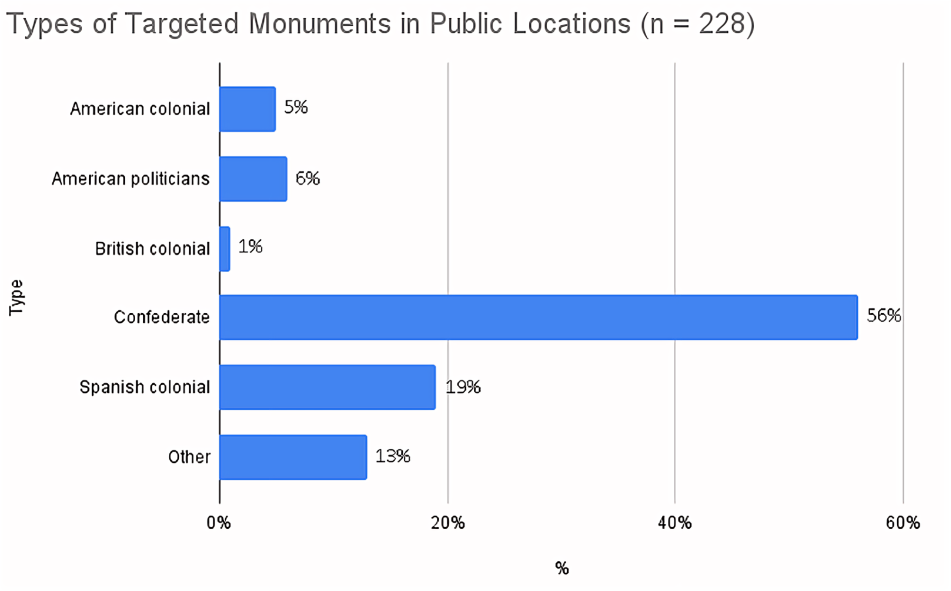 Note. The overall classification of targeted monuments in public spaces in the United States during the social justice protests from spring 2020 to spring 2022. (Graph by Gilbert C. Correa)
Note. The overall classification of targeted monuments in public spaces in the United States during the social justice protests from spring 2020 to spring 2022. (Graph by Gilbert C. Correa)
In figure 3, the largest group of the 228 targeted monuments in public spaces were confederate monuments (129 or 56%). Statues commemorating the Confederacy have been targeted because they have become “political flashpoints” (De Witte 2020).
Figure 4
Types of Targeted Monuments in Private Locations (n = 33)
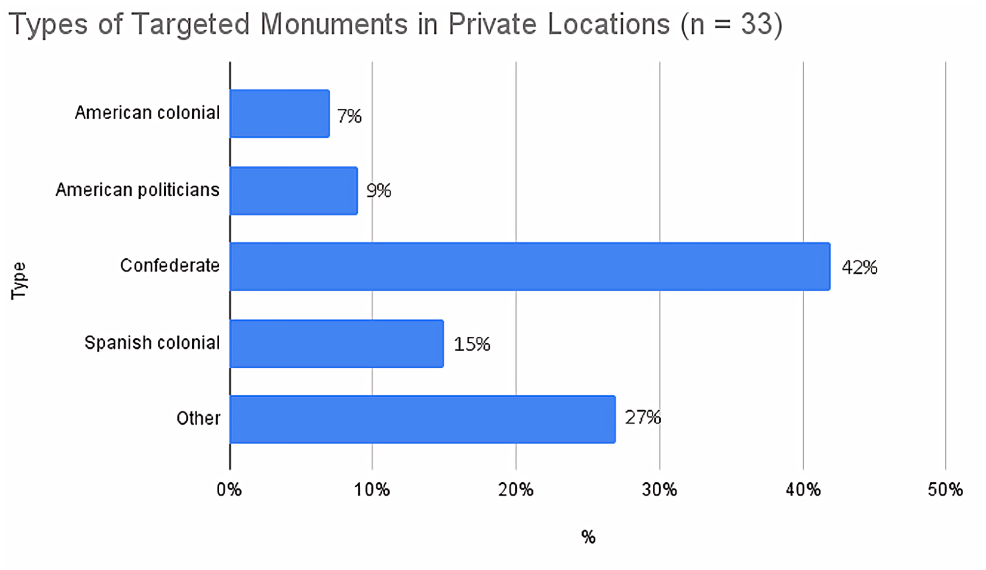
Note. The overall classification of targeted monuments in private spaces in the United States during the social justice protests from spring 2020 to spring 2022. (Graph by Gilbert C. Correa)
In figure 4, the largest group were confederate monuments (14 or 42%) of the 33 targeted monuments in private spaces. Individuals demanded their removal because they are symbols of racism and oppression (De Witte 2020).
Figure 5
Social Justice Protests that Affected Monuments (Spring 2020-Spring 2022) in Public vs Private Locations (n = 261)
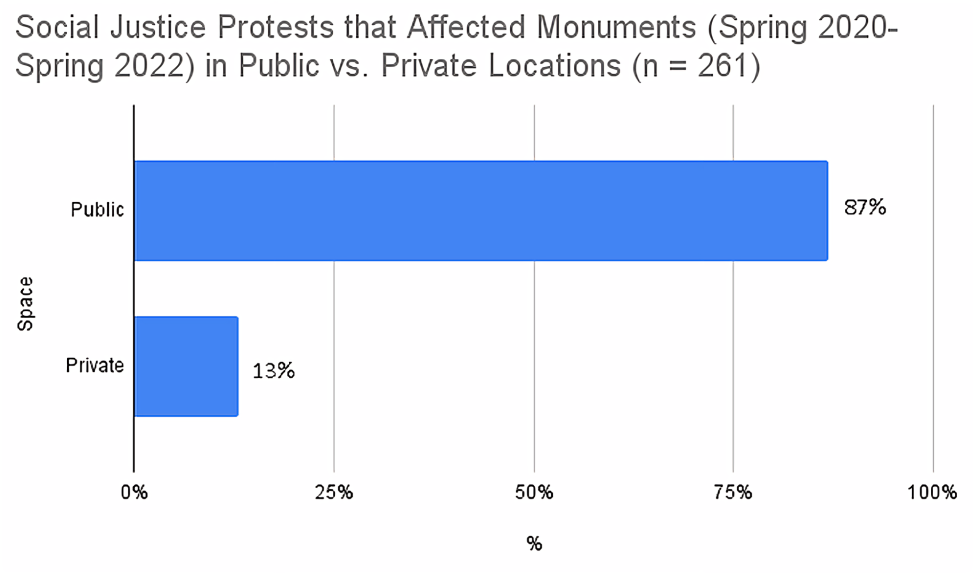
Note. Types of locations where the social justice protests directly affected monuments. (Graph by Gilbert C. Correa)
As detailed in figure 5, public spaces (228 or 87%) far exceed private spaces (33 or 13%) of the 261 total incidents. Public spaces are easily accessible to people; whereas, private spaces are typically closed off and one can receive serious penalties for damaging private property.
Figure 6
Types of Public Locations with Targeted Monuments (n = 228)
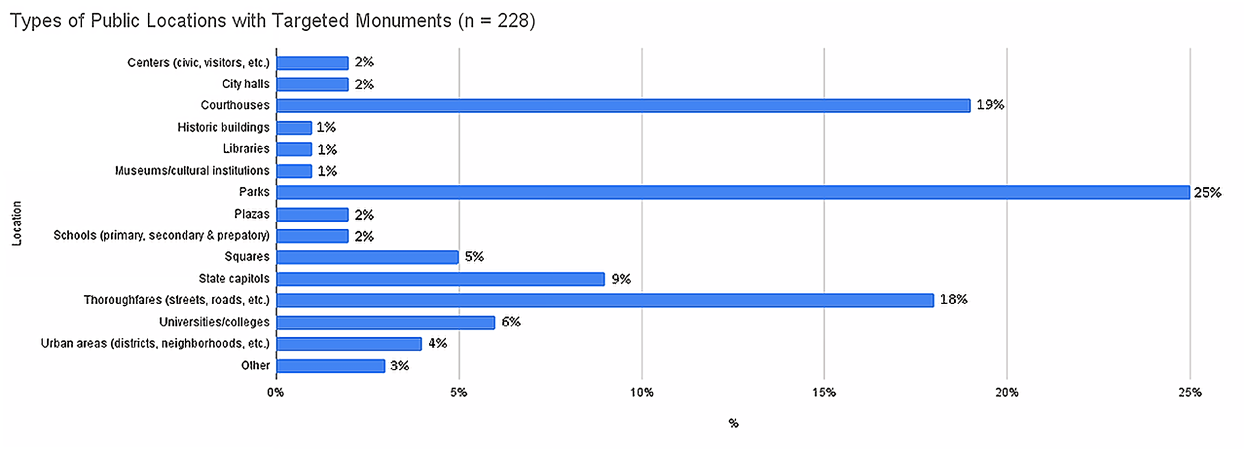
Note. Types of public locations where the social justice protests directly affected monuments. (Graph by Gilbert C. Correa)
Of the 228 public spaces, the top three with the greatest number of social justice protests that directly impacted monuments were as follows in Figure 6: I) parks (58 or 25%); II) courthouses (44 or 19%) and; III) thoroughfares like roads, streets, avenues, etc. (40 or 18%). Parks, courthouses and thoroughfares are the most transited of all public spaces. They possess the largest number of monuments that make “a statement about the ideas, values, or individuals they think their society should remember, if not honor” (Facing History & Ourselves 2020).
Figure 7
Types of Private Locations with Targeted Monuments (n = 33)
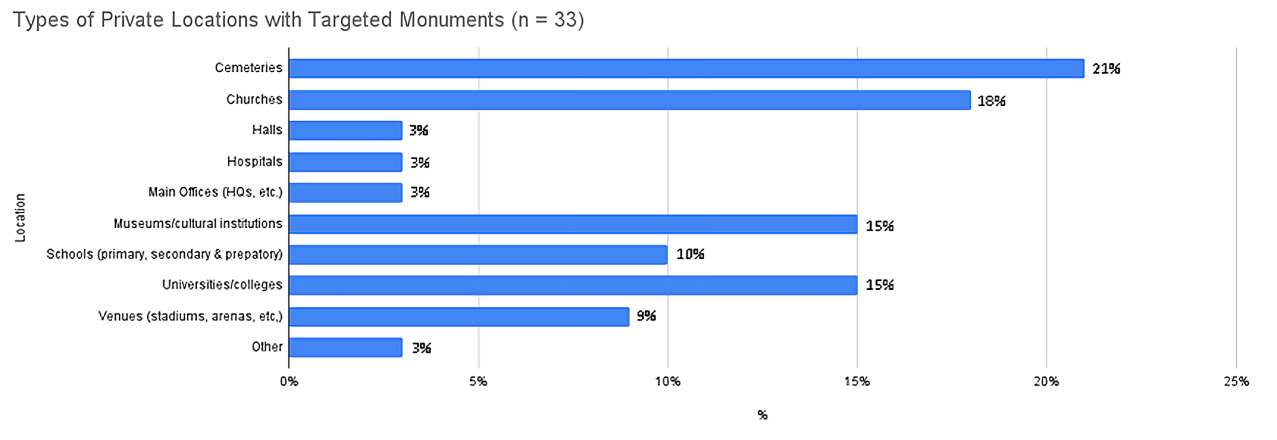
Note. Types of private locations where social justice protests directly affected monuments. (Graph by Gilbert C. Correa)
Of the 33 private spaces, the top three with the greatest number of social justice protests that directly impacted monuments were as follows in Figure 7: I) cemeteries (7 or 21%); II) churches (6 or 18%) and; III) museums/cultural institutions and universities/colleges (5 or 15%). While cemeteries, churches, museums, and other cultural institutions such as galleries, are private, they are also easily accessible. These spaces feature monuments that glorify specific figures and display the admiration of proprietors (Tuccille 2020).
Local news agencies like WBRC in Birmingham, Alabama, and broadcast networks like ABC News announced in the wake of the George Floyd protests that many monuments would be promptly removed. Interestingly enough, some monuments like the Equestrian Statue of Don Juan de Oñate in Alcalde, New Mexico, had been the subject of controversy and years-long discussion prior to the George Floyd Protests (Romero 2017). In some instances, the efforts to remove monuments required legislation and formal court proceedings, such as the Virginia Supreme Court’s unanimous ruling that affirmed the power of Gov. Ralph Northam to remove the Robert E. Lee Statue located on Monuments Avenue in Richmond, Virginia, in the autumn of 2021 (Patel 2021). In other places, laws were passed to protect Confederate monuments and prohibit their removal without prior state approval, such as the Alabama Memorial Preservation Act and South Carolina Heritage Act (Hearst Television 2020).
Please stay tuned as there is more to come from the Monuments Toolkit Project.
References
De Witte, Melissa (2020). “Controversies over Confederate monuments and memorials are part of an overdue racial reckoning for America, says Stanford historian.” Stanford News Service. 16th of July 2020. https://news.stanford.edu/2020/07/16/confederate-monuments-coming-now/
Facing History & Ourselves Website (2020). “Lesson: After Charlottesville: Public Memory and the Contested Meaning of Monuments.” Facing History & Ourselves. 3rd of February 2020. https://www.facinghistory.org/resource-library/after-charlottesville-public-memory-and-contested-meaning-monuments
Hearst Television (2020). “As Confederate monuments come down, some states have laws that protect their removal.” The Telegraph. 10th of July 2020. https://www.thetelegraph.com/news/article/As-Confederate-monuments-come-down-some-states-15382654.php
Mathias, Christopher (2020). “Over 100 Confederate Symbols Removed Or Renamed Since George Floyd Killing.” HuffPost. 14th of October 2020. https://www.huffpost.com/entry/100-confederate-symbols-removed-since-george-floyd_n_5f86255cc5b681f7da1c9d04
Patel, Vimal (2021). “Virginia Supreme Court Clears Path for Removal of Robert E. Lee Statue.” The New York Times. 2nd of September 2021. https://www.nytimes.com/2021/09/02/us/robert-e-lee-statue-removal-virginia.html
Romero, Simon (2017). “Statue’s Stolen Foot Reflects Divisions Over Symbols of Conquest.” New York Times. 30th of September 2017. https://www.nytimes.com/2017/09/30/us/statue-foot-new-mexico.html
Tuccille, J.D. (2020). “All Statues Should Be Private.” Reason: Free Minds and Free Market. 24th of June 2020. https://reason.com/2020/06/24/all-statues-should-be-private/
Feature photo: Victoria Pickering (2020). “Albert Pike statue.” June 20, 2020, Washington, D.C. <https://www.flickr.com/photos/vpickering/50044455571> License: CC BY-NC-ND 2.0

